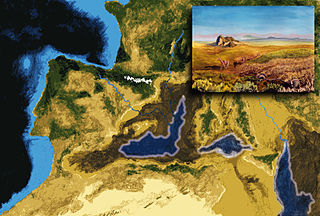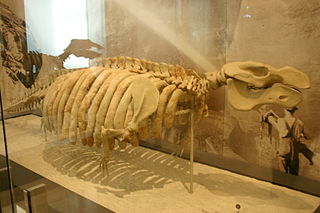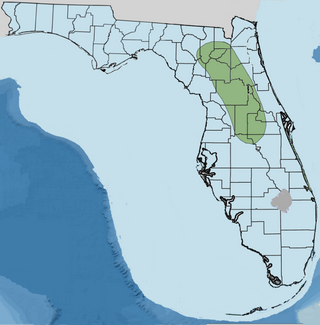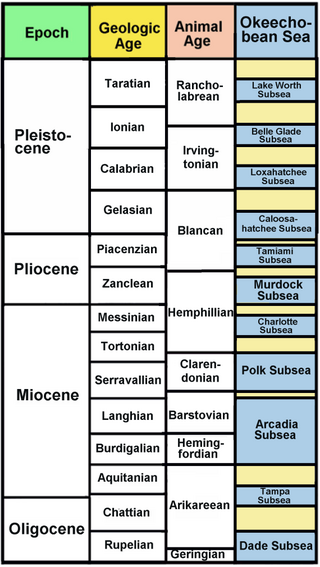
The Choctaw Sea was a Cenozoic eutropical subsea, which along with the Okeechobean Sea, occupied the eastern Gulf of Mexico basin system bounding Florida.

The Choctaw Sea was a Cenozoic eutropical subsea, which along with the Okeechobean Sea, occupied the eastern Gulf of Mexico basin system bounding Florida.
The Choctaw Sea was named for the Choctaw or Choctawhatchee River of northern Oligocene Florida. It occupied most of the Florida Panhandle including the river deltas of the Choctawhatchee River, Apalachicola River, and Ochlockonee River. At its maximum coverage it encompassed an area as far north as the city of Bainbridge in Southwest Georgia and as far to the southeast as Taylor County, Florida, United States.

The Choctaw Sea was divided further into two groups of three sub-seas based upon marine fauna. These sub-seas were named:

The Bainbridge Subsea was named for the fossil beds of Bainbridge, Georgia and is the oldest subsea. This period spanned the existence of the Gulf Trough between Georgia and Florida's Orange Island. It was a warm but cooling climate, moving towards an ice age. The Suwannee Limestone was established during this time. Basilosaurus cetoides and Zygorhiza , early toothed whales, as well as Protosiren , an extinct ancestor of the Manatee, inhabit these waters and are the earliest mammal fossils uncovered with specimens from Citrus County in dolomite ~40—37 Ma. and Marion County, Florida dating from 37.2—33.9 Ma. [1] [2]

The Chattahoochee Subsea was named for the Chattahoochee Formation which formed during the rise in sea level. The Chattahoochie Subsea was much smaller in size than the Bainbridge and during the filling of the Chattahoochee, the St. Marks Formation of limestone and sand was established. The Gulf Trough closed between Georgia and Florida forming the complete Florida peninsula allowing land animals to move southward. The fossil record shows that land animals entered the newly formed peninsula ~24.8 Ma. [3]
The Chipola Subsea was named after the Chipola Formation and was formerly known as the Chipola Sea. It was created by rising sea level flooding the area once again. The Torreya Formation, [4] a geologic formation extending from Gadsden to Hamilton County was established during this period. A somewhat narrow land bridge exists with a width from Madison County to Duval County, Florida extending into Georgia. The Middle Miocene Disruption, an extinction of many mammal genera begins.
A very short dry period follows the Chipola lasting possibly 1 million years. During the time the Middle Miocene Disruption continues. Forests slowly draw in massive amounts of carbon dioxide, gradually lowering the level of atmospheric CO2 from 650 ppmv down to around 100 ppmv.
The Walton Subsea was named for the fossil beds of Walton County.

The Alaqua Subsea was named for the fossil beds found along Alaqua Creek, Walton County. The period of time after the Alaqua experienced a somewhat long dry period. A major event was the Messinian salinity crisis or dry Mediterranean. It was replenished with the Zanclean flood which raised the world-wide sea level 10 meters or 33 feet. [5]
The Jackson Subsea was named after the Jackson Bluff Formation and formerly called the "Jackson Sea." It was created during the rise in sea level during the Pliocene. During this period the last glacial period known as the Wisconsin ice age begins.
The Neogene is a geologic period and system that spans 20.45 million years from the end of the Paleogene Period 23.03 million years ago (Mya) to the beginning of the present Quaternary Period 2.58 Mya. The Neogene is sub-divided into two epochs, the earlier Miocene and the later Pliocene. Some geologists assert that the Neogene cannot be clearly delineated from the modern geological period, the Quaternary. The term "Neogene" was coined in 1853 by the Austrian palaeontologist Moritz Hörnes (1815–1868).
The Pliocene is the epoch in the geologic time scale that extends from 5.333 million to 2.58 million years ago. It is the second and most recent epoch of the Neogene Period in the Cenozoic Era. The Pliocene follows the Miocene Epoch and is followed by the Pleistocene Epoch. Prior to the 2009 revision of the geologic time scale, which placed the four most recent major glaciations entirely within the Pleistocene, the Pliocene also included the Gelasian Stage, which lasted from 2.588 to 1.806 million years ago, and is now included in the Pleistocene.

The Messinian salinity crisis was a geological event during which the Mediterranean Sea went into a cycle of partial or nearly complete desiccation (drying-up) throughout the latter part of the Messinian age of the Miocene epoch, from 5.96 to 5.33 Ma. It ended with the Zanclean flood, when the Atlantic reclaimed the basin.
The Messinian is in the geologic timescale the last age or uppermost stage of the Miocene. It spans the time between 7.246 ± 0.005 Ma and 5.333 ± 0.005 Ma. It follows the Tortonian and is followed by the Zanclean, the first age of the Pliocene.
The Langhian is, in the ICS geologic timescale, an age or stage in the middle Miocene Epoch/Series. It spans the time between 15.97 ± 0.05 Ma and 13.65 ± 0.05 Ma during the Middle Miocene.
The Tortonian is in the geologic time scale an age or stage of the late Miocene that spans the time between 11.608 ± 0.005 Ma and 7.246 ± 0.005 Ma. It follows the Serravallian and is followed by the Messinian.

The Molasse basin is a foreland basin north of the Alps which formed during the Oligocene and Miocene epochs. The basin formed as a result of the flexure of the European plate under the weight of the orogenic wedge of the Alps that was forming to the south.

The Sorbas Basin is a sedimentary basin around the town of Sorbas in Almeria Province in south-east Spain. It is believed to have been formed by extension, between two fault-bounded blocks which rotated anti-clockwise to take up the compression resulting from Europe's collision with Africa. The basin is filled with turbidites and evaporites of the Tortonian-Messinian ages of the Miocene Epoch.

Metaxytherium is an extinct genus of dugong that lived from the Oligocene until the end of the Pliocene. Fossil remains have been found in Africa, Europe, North America and South America. Generally marine seagrass specialists, they inhabited the warm and shallow waters of the Paratethys, Mediterranean, Caribbean Sea and Pacific coastline. American species of Metaxytherium are considered to be ancestral to the North Pacific family Hydrodamalinae, which includes the giant Steller's Sea Cow.
The Turolian age is a period of geologic time within the Miocene used more specifically with European Land Mammal Ages. It precedes the Ruscinian age and follows the Vallesian age. The Turolian overlaps the Tortonian and Messinian ages.

The Torreya Formation is a Miocene geologic formation with an outcrop in North Florida. It is within the Hawthorn Group.

The Betic Corridor, or North-Betic Strait, was a strait of water connecting the Mediterranean Sea with the Atlantic Ocean that once separated the Iberian plate from the Eurasian plate through the Betic Cordillera. Its closure approximately 5.96 million years ago during the Messinian period of the Miocene epoch, precipitated the Messinian Salinity Crisis, a period when the Mediterranean Sea evaporated partly or completely.

The Hawthorn Group is a stratigraphic unit that includes several geologic formations of Late Oligocene to Pliocene age in North Florida, United States. It is known for its phosphate rock resources, and for its rich assemblages of Neogene vertebrate fossils. It was originally called the Waldo Formation by L.C. Johnson of the United States Geological Survey in 1887, and later became the Hawthorne Group named for Hawthorne, Florida, where its phosphate-rich rock was quarried and processed for use as fertilizer.

The Chipola Formation is a Late Oligocene to Early Miocene geologic formation in the Florida Panhandle and member of the Alum Bluff Group.

Orange Island is the earliest emergent landmass of Florida dating from the middle Rupelian ~33.9—28.4 Ma. geologic stage of the Early Oligocene epoch and named for Orange County, Florida, United States of America.

The Okeechobean Sea was a Cenozoic eutropical subsea, which along with the Choctaw Sea, occupied the eastern Gulf of Mexico basin system bounding Florida.
The Alum Bluff Group is a geologic group in the states of Georgia, Florida, and Alabama. It preserves fossils dating back to the Neogene period.
The Santa Cruz Mudstone is a geologic formation in California. The siliceous organic mudstones of the formation were deposited in deep water and fluvial environments. The formation overlies the Santa Margarita Sandstone and is overlain by the Purisima Formation. The Santa Cruz Mudstone was formerly considered part of the Monterey Formation. The formation preserves bivalve and echinoid fossils as well as vertebrates of Parabalaenoptera baulinensis and Otodus megalodon. The formation dates back to the Late Miocene period.

The Geology of Malta consists of a sequence of sedimentary rocks of late Oligocene to late Miocene age cut through by a set of extensional faults of Pliocene age.

Balaenoptera siberi is an extinct species of baleen whale from the Late Miocene, described by Pilleri and Pilleri in 1989, based on fossils found in the Pisco Formation of the Pisco Basin in southwestern Peru.